Soundcraft Signature 22 MTK, Signature 22, Signature 16 User Guide
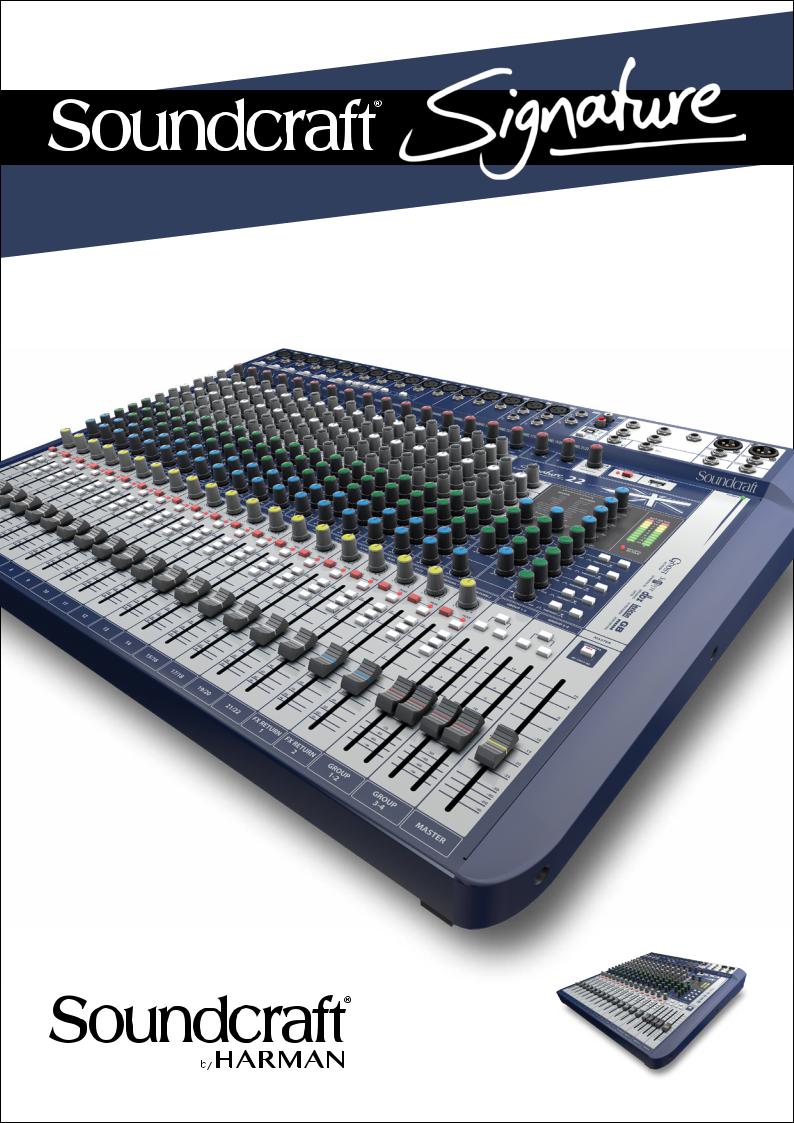
User Guide
For Soundcraft Signature 16, 22 & 22MTK

16, 22, 22MTK User Manual |
INFORMATION |
|
|
INFORMATION
IMPORTANT
Please read this manual carefully before using your mixer for the first time.
This equipment complies with the EMC directive 2004/108/EC and LVD 2006/95/EC.
This product is approved to safety standards:
IEC 60065:2005 (Seventh Edition) +A1:2005
EN60065:2006 +A1:2006 +A1:2008
UL60065 2012 7th Edition
CAN/CSA-E60065-03 + A1: 2006
And EMC standards
EN55103-1: 2009 (E2)
EN55103-2: 2009 (E2)
Warning: Any modification or changes made to this device, unless explicitly approved by Harman, will invalidate the authorisation of this device. Operation of an unauthorised device is prohibited under Section 302 of the Communications act of 1934, as amended, and Subpart 1 of Part 2 of Chapter 47 of the Code of Federal Regulations.
NOTE: This equipment has been tested and found to comply with the limits for a Class B digital device, pursuant to Part 15 of the FCC Rules. These limits are designed to provide reasonable protection against harmful interference in a residential installation. This equipment generates, uses and can radiate radio frequency energy and, if not installed and used in accordance with the instructions, may cause harmful interference to radio communications. However, there is no guarantee that interference will not occur in a particular installation. If this equipment does cause harmful interference to radio or television reception, which can be determined by turning the equipment off and on, the user is encouraged to try to correct the interference by one or more of the following measures:
*Reorient or relocate the receiving antenna.
*Increase the separation between the equipment and the receiver.
*Connect the equipment into an outlet on a circuit different from that to which the receiver is connected.
*Consult the dealer or an experienced radio/TV technician for help.
For further details contact: Harman International Industries Ltd, Cranbourne House, Cranbourne Road, Potters Bar, Hertfordshire EN6 3JN, UK. Telephone +44 (0)1707 665000 Fax: +44 (0)1707 660742 email: soundcraft@harman.com
© Harman International Industries Ltd. 2014. All rights reserved.
Parts of the design of this product may be protected by worldwide patents. Part No. 5056808
Rev 1.1
E&OE September 2014
Soundcraft is a trading division of Harman International Industries Ltd. Information in this manual is subject to change without notice and does not represent a commitment on the part of the vendor. Soundcraft shall not be liable for any loss or damage whatsoever arising from the use of information or any error contained in this manual. No part of this manual may be reproduced, stored in a retrieval system, or transmitted, in any form or by any means, electronic, electrical, mechanical, optical, chemical, including photocopying and recording, for any purpose without the express written permission of Soundcraft.
Harman International Industries Limited
Cranborne House, Cranborne Road, Potters Bar, Hertfordshire, EN6 3JN, UK
Tel: +44 (0)1707 665000
Fax: +44 (0)1707 660742
http://www.soundcraft.com INFORMATION

16, 22, 22MTK User Manual |
CONTENTS |
|
|
CONTENTS
1.0AN INTRODUCTION TO SIGNATURE
1.0.1The Signature Legacy
1.0.2Sapphyre Asymmetric EQ
1.1: Safety
1.2: Warranty
1.3: Specifications
2.0: GETTING STARTED
2.1: Introduction To Consoles
2.2: Parts Of The Console
3.0: INPUTS AND OUTPUTS
3.1: Introduction to I/O
3.2: Console Inputs
3.3: Console Outputs
3.4: Other I/O
4.0: CONSOLE ROUTING
4.1: Mono Input Channel
4.1: Stereo Input Channel
4.3: FX Return Channel
4.4: Aux Master Output
4.5: Group Master Output
4.6: Master Stereo Output
5.0: CHANNEL CONTROLS
5.1: Input Controls
5.1.1: Mono Input Controls
5.1.2: Stereo Input Controls
5.1.3: FX Return Controls
5.2: Aux Master Controls
5.3: Group Master Controls
5.4: Master Stereo Controls
6.0: SOLO AND MONITORING
7.0: USB OPERATION
7.1: Signature 16, 22 USB
7.2: Signature 22MTK USB
8.0: LEXICON FX
8.1: FX Control
8.2: Reverbs
8.3: Delays And Modulation
APPENDIX 01: NO SOUND?
For clarity, this manual uses section references rather than page numbers. In some instances, one section reference may extend to several pages.
CONTENTS
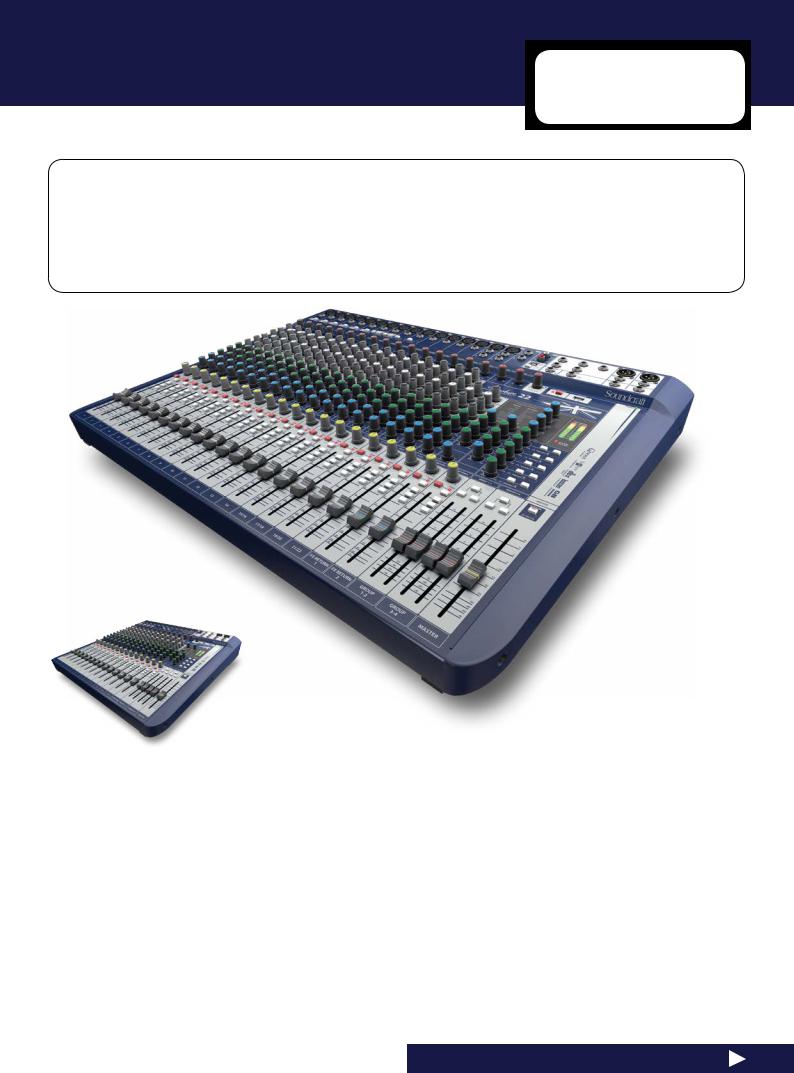
 16, 22, 22MTK User Manual
16, 22, 22MTK User Manual
1.0: INTRODUCTION
INTRODUCTION TO SIGNATURE
Drawing on over 40 years experience in live sound mixing, the Signature Series combines a superb analogue control surface with the unrivalled British sound of Soundcraft in a powerful, compact, professionally spec’d mixer.
Built tough for trouble-free performance night-after-night, Signature Series mixers deliver great sounding results thanks to high-grade Ghost® preamps, the most musical EQ in the business, pristine Lexicon® effects and powerful dbx® dynamics - all designed to let you discover your Signature sound.
• Soundcraft® Ghost Mic Preamps
Class-leading performance, with high headroom, wide dynamic range and superb signal to noise ratio.
• Soundcraft® Sapphyre British EQ
Famed for its musical sound and unmistakable ‘British’ quality
• Soundcraft® GB audio routing
Flexible pre/post switching on each Aux and subgroups with powerful routing and switching options as well as dedicated outputs.
• dbx® Limiters
High performance, high-ratio Compressors on selected input channels.
• Hi-Z instrument inputs
Switchable input stage, optimised for acoustic guitars, electric guitars, and basses.
• Award-winning Lexicon® effects
Studio-grade Reverbs, Delays, Choruses and Modulations, designed to add a truly professional edge to your productions.
• USB Digital Audio
USB digital I/O for direct connection to Digital Audio Workstations and digital systems. Signature MTK version adds MultiTrack functionality.
• Playback Channel Functions
‘Interval Mute’ fast switching of playback channel to main outputs, plus in-dependant Pre/Post Aux switching.
• Built tough for the long haul
Robust metal construction and premium-quality components: Built to withstand the rigours of extensive use.
1.0: INTRODUCTION TO SIGNATURE
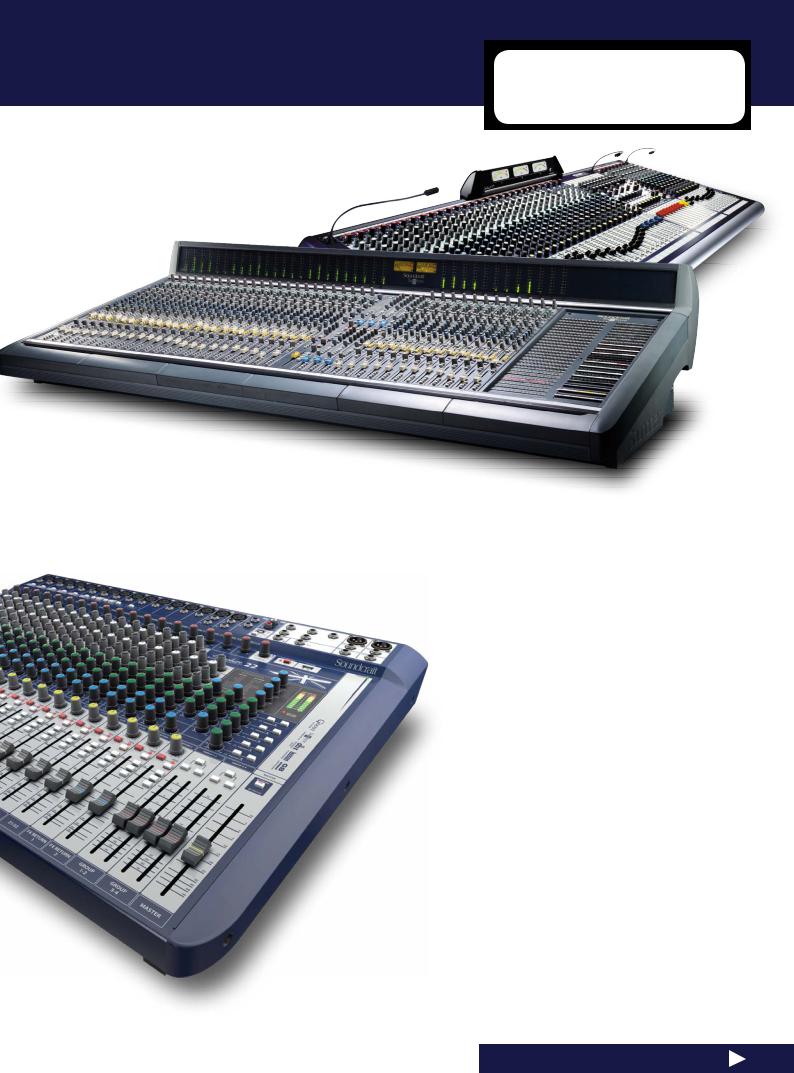
 16, 22, 22MTK User Manual
16, 22, 22MTK User Manual
1.0.1: SIGNATURE LEGACY
SIGNATURE LEGACY
The Signature Series consoles bring musicality, creativity, and technical excellence together, thanks not only to new technology and ideas, but also to a 40-year legacy of producing outstanding performance tools. This console incorporate classic analogue designs, approved by Engineers.
Ghost® pre-amps
The Soundcraft Ghost console’s ProMic mic pre-amp is known for it’s ultra-low noise and high headroom, making high gain settings possible, without compromising signal integrity.
Sapphyre British EQ
The Soundcraft Sapphyre console Asymmetric EQ makes both creative and functional tonal shaping of your signal simple and intuitive. The EQ behaves differently in cut and boost, making tonal adjustments musical, and focusing cuts where they are needed. See section 1.0.2 for more detail.
GB Routing
The GB Console legacy is in Signature’s signal routing. There is pre/post switching for all aux busses, plus flexible routing and dedicated outputs for sub-groups.
See section 4 for more detail.
1.0.1: SIGNATURE LEGACY
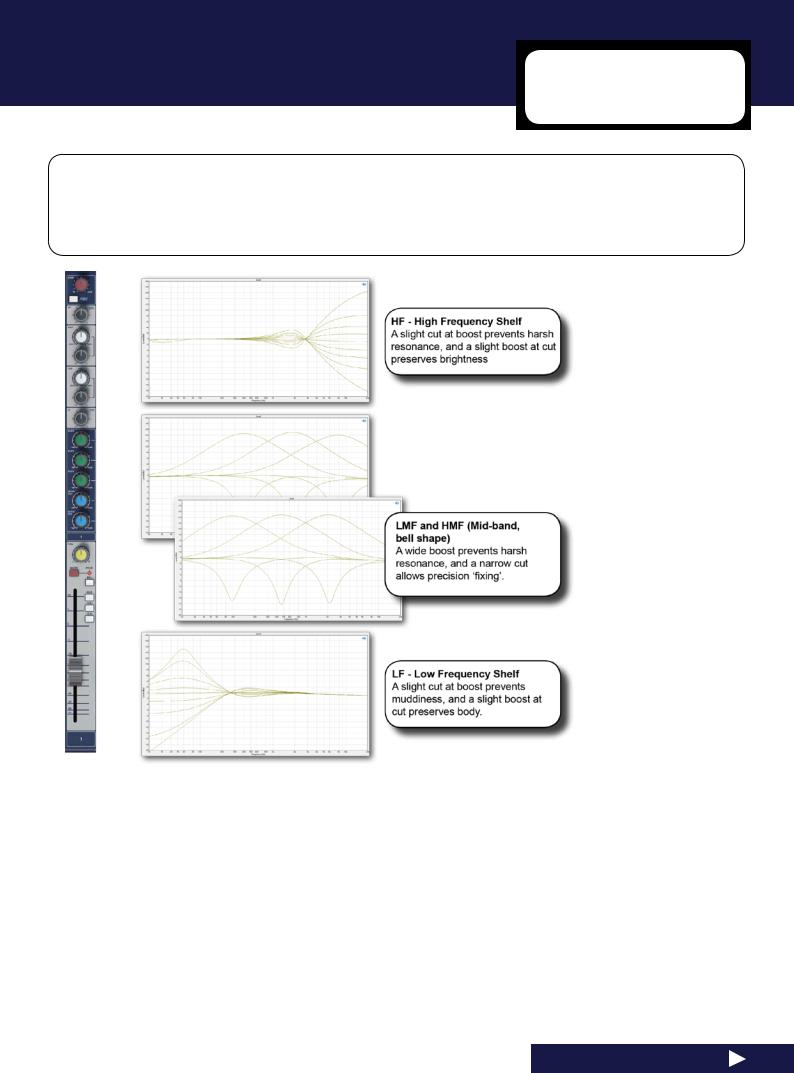
 16, 22, 22MTK User Manual
16, 22, 22MTK User Manual
1.0.2: SAPPHYRE EQ
SAPPHYRE EQ
Soundcraft Sapphyre Asymmetric EQ
The Soundcraft Signature console uses a special Asymmetric EQ first developed for the renowned
Soundcraft Sapphyre console. This EQ makes both creative and functional tonal shaping of your signal simple and intuitive - an EQ that works the way music does.
The shelving bands of the EQ (LF and HF) use a slight boost at the EQ’s frequency when cutting, and a slight cut when boosting.
For low frequencies, a slight cut when boosting prevents muddiness in he signal, while a slight boost when cutting enables you to clean up the low end without losing precious ‘punch’ and ‘body’ of the signal. For the HF shelf, a slight cut when boosting prevents harsh resonance at the EQ’s frequency, and a slight boost before a cut can help maintain brightness while reducing HF.
The mid-bands (bell-shape) have a wide bandwidth (low Q) when boosting, and a narrower bandwidth (high Q) when cutting.
The wide boost prevents prevent harsh resonances and tonal-changes that allow for a more pleasing and musical EQ boost. The Narrow cut focuses on problematic frequencies, for getting rid of resonances, rings, hums, and preventing feedback. If this was too wide you could remove too much ‘body’, creating a thin sound.
1.0.2: SAPPHYRE EQ
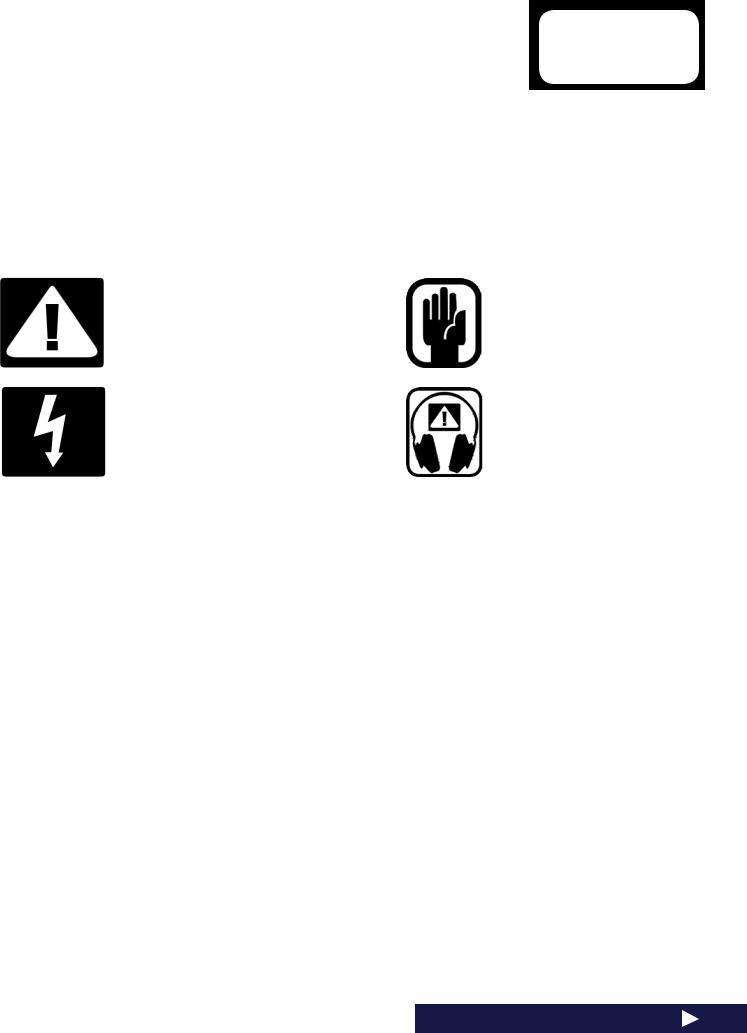
16, 22, 22MTK User Manual |
1.1: SAFETY |
|
|
INTRODUCTION > SAFETY
SAFETY NOTICES
For your own safety and to avoid invalidation of the warranty please read this section carefully.
Important Symbols
Cautions
Alerts the user to the presence of important operating and maintenance (servicing) instructions in the literature accompanying the appliance.
Warnings
Alerts the user to the presence of uninsulated ‘dangerous voltage’ within the product’s enclosure that may be of insufficient magnitude to constitute a risk of electric shock to persons.
THIS UNIT MUST BE EARTHED
Under no circumstances should the mains earth be disconnected from the mains lead.
The wires in the mains lead are coloured in accordance with the following code:
Earth: Green and Yellow (Green/Yellow - US)
Neutral: Blue (White - US)
Live (Hot): Brown (Black - US)
As the colours of the wires in the mains lead may not correspond with the coloured markings identifying the terminals in your plug, proceed as follows:
The wire which is coloured Green and Yellow must be connected to the terminal in the plug which is marked with the letter E or by the earth symbol.
The wire which is coloured Blue must be connected to the terminal in the plug which is marked with the letter N.
The wire which is coloured Brown must be connected to the terminal in the plug which is marked with the letter L.
Ensure that these colour codings are followed carefully in the event of the plug being changed.
This unit is capable of operating over a range of mains voltages as marked on the rear panel.
The internal power supply unit contains no user serviceable parts. Refer all servicing to a qualified service engineer, through the appropriate Soundcraft dealer.
1.1: INTRODUCTION > SAFETY

16, 22, 22MTK User Manual |
1.1: SAFETY |
|
|
INTRODUCTION > SAFETY
WARNINGS
•Read these instructions.
•Keep these instructions.
•Heed all warnings.
•Follow all instructions.
•Clean the apparatus only with a dry cloth.
•Do not install near any heat sources such as radiators, heat resistors, stoves, or other apparatus
(including amplifiers) that produce heat.
•Do not block any ventilation openings. Install in accordance with the manufacturer’s instructions.
•Do not use this apparatus near water.
•Do not defeat the safety purpose of the polarized or grounding type plug. A polarized plug has two blades with one wider than the other. A grounding type plug has two blades and a third grounding prong. The wide blade or the third prong are provided for your safety. When the provided plug does not fit into your outlet, consult an electrician for replacement of the obsolete outlet.
•Protect the power cord from being walked on or pinched particularly at plugs, convenience receptacles and the point where they exit from the apparatus.
•Only use attachments/accessories specified by the manufacturer.
•Unplug this apparatus during lightning storms or when unused for long periods of time.
•Refer all servicing to qualified service personnel. Servicing is required when the apparatus has been damaged in any way such as power-supply cord or plug is damaged, liquid has been spilled or objects have fallen into the apparatus, the apparatus has been exposed to rain or moisture, does not operate normally, or has been dropped.
•Use only with the cart, stand, tripod, bracket, or table specified by the manufacturer, or sold with the apparatus. When the cart is used, use caution when moving the cart/apparatus combination to avoid injury from tip-over.
•No naked flame sources, such as lighted candles or cigarettes etc., should be placed on the apparatus.
•No user serviceable parts. Refer all servicing to a qualified service engineer, through the appropriate Soundcraft dealer.
•It is recommended that all maintenance and service on the product should be carried out by Soundcraft or its authorised agents. Soundcraft cannot accept any liability whatsoever for any loss or damage caused by service, maintenance or repair by unauthorised personnel.
•WARNING: To reduce the risk of fire or electric shock, do not expose this apparatus to rain or moisture. Do not expose the apparatus to dripping or splashing and do not place objects filled with liquids, such as vases, on the apparatus. No naked flame sources, such as lighted candles, should be placed on the apparatus.
•Ventilation should not be impeded by covering the ventilation openings with items such as newspapers, table cloths, curtains etc.
1.1: INTRODUCTION > SAFETY
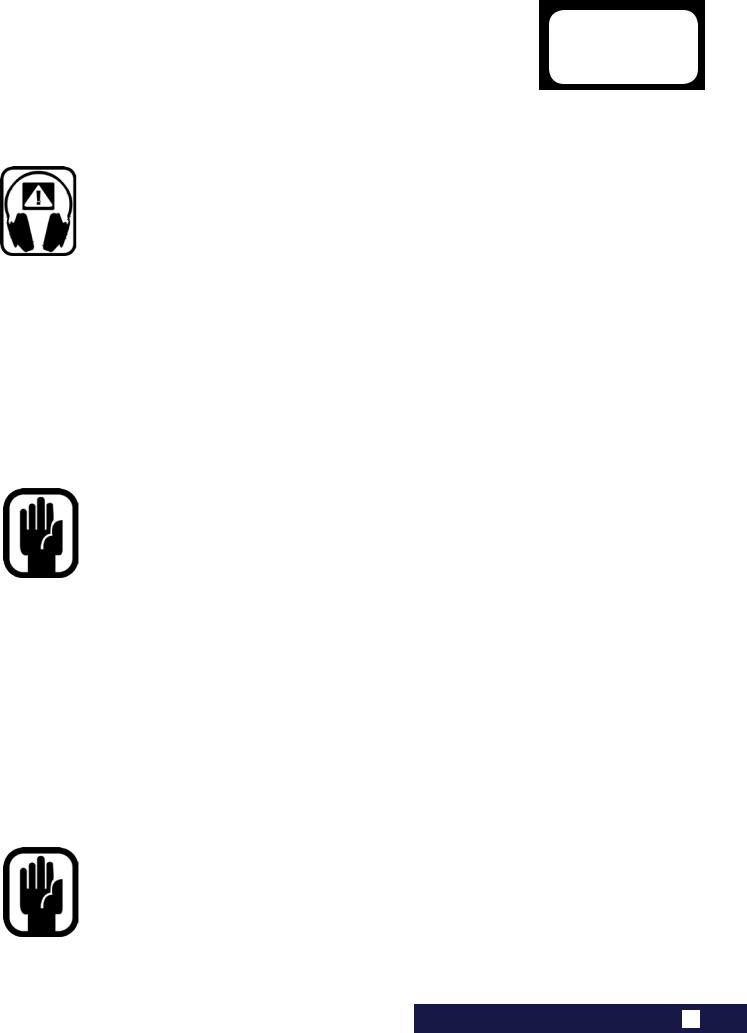
16, 22, 22MTK User Manual |
1.1: SAFETY |
|
|
INTRODUCTION > SAFETY
WARNINGS
ADVICE FOR THOSE WHO PUSH THE BOUNDARIES
Although your new console will not output any sound until you feed it signals, it has the capability to produce sounds which, when monitored through an amplifier or headphones, can damage hearing over time.
Please take care when working with your audio — if you are manipulating controls which you don’t understand (which we all do when we are learning), make sure your monitors are turned down. Remember that your ears are the most important tool of your trade, look after them, and they will look after you.
Most importantly — don’t be afraid to experiment to find out how each parameter affects the sound — this will extend your creativity and help.
NOTE: This equipment has been tested and found to comply with the limits for a Class B digital device, pursuant to Part 15 of the FCC Rules. These limits are designed to provide reasonable protection against harmful interference when the equipment is operated in a commercial environment. This equipment generates, uses and can radiate radio frequency energy and, if not installed and used in accordance with the instruction manual, may cause harmful interference to radio communications. Operation of this equipment in a residential
area is likely to cause harmful interference in which case the user will be required to correct the interference at his own expense.
This Class B digital apparatus meets the requirements of the Canadian Interference-Causing Equipment Regulations.
Cet appareil numérique de la Classe B respecte toutes les exigences du Règlement sur le matériel brouilleur du Canada.
NOTE: The packaging, in which your console arrived, forms part of the product and must be retained for future use.
1.1: INTRODUCTION > SAFETY

 16, 22, 22MTK User Manual
16, 22, 22MTK User Manual
1.2: WARRANTY
INTRODUCTION > SAFETY
WARRANTY
1 Soundcraft is a trading division of Harman International Industries Ltd.
End User means the person who first puts the equipment into regular operation.
Dealer means the person other than Soundcraft (if any) from whom the End User purchased the Equipment, provided such a person is authorised for this purpose by Soundcraft or its accredited Distributor.
Equipment means the equipment supplied with this manual.
2 If within the period of twelve months from the date of delivery of the Equipment to the End User it shall prove defective by reason only of faulty materials and/or workmanship to such an extent that the effectiveness and/or usability thereof is materially affected the Equipment or the defective component should be returned to the Dealer or to Soundcraft and subject to the following conditions the Dealer or Soundcraft will repair or replace the defective components. Any components replaced will become the property of Soundcraft.
3 Any Equipment or component returned will be at the risk of the End User whilst in transit (both to and from the Dealer or Soundcraft) and postage must be prepaid.
4 This warranty shall only be available if:
a)The Equipment has been properly installed in accordance with instructions contained in Soundcraft’s manual.
b)The End User has notified Soundcraft or the Dealer within 14 days of the defect appearing; and
c)No persons other than authorised representatives of Soundcraft or the Dealer have effected any replacement of parts maintenance adjustments or repairs to the Equipment; and
d)The End User has used the Equipment only for such purposes as Soundcraft recommends, with only such operating supplies as meet Soundcraft’s specifications and otherwise in all respects in accordance Soundcraft’s recommendations.
5 Defects arising as a result of the following are not covered by this Warranty: faulty or negligent handling, chemical or electro-chemical or electrical influences, accidental damage, Acts of God, neglect, deficiency in electrical power, air-conditioning or humidity control.
6.The benefit of this Warranty may not be assigned by the End User.
7.End Users who are consumers should note their rights under this Warranty are in addition to and do not affect any other rights to which they may be entitled against the seller of the Equipment.
1.2: INTRODUCTION > WARRANTY

16, 22, 22MTK User Manual |
|
|
|
|
|
1.3: SPECIFICATIONS |
|
||
|
|
|
|
|
INTRODUCTION > SPECIFICATIONS |
|
|
|
|
Operating Conditions |
|
|
||
TYPICAL SPECIFICATIONS |
|
|
||
|
- Temperature Range: 5°C to 40°C |
|||
• Frequency Response |
|
|
|
|
- Mic / Line In to any Output: +/-1.5dB, 20Hz-20kHz |
Input & Output Levels |
|
|
|
|
- Mic Input: +12.5dBu max |
|||
• T.H.D. |
- Line Input: >+26dBu max |
|||
- Mono Mic Sensitivity -30dBu, Input level -16dBu, |
- Stereo Inputs: >+26dBu max |
|||
+14dBu @ Mix output: < 0.002% @ 1kHz |
- Mix Output: +21.5dBu max |
|||
- Stereo Mic Sensitivity -30dBu, Input level -16dBu, |
- Headphones (@150Ω): 300mW |
|||
+14dBu @ Mix output: < 0.007% @ 1kHz |
|
|
|
|
|
Input & Output Impedances |
|||
• Noise |
- Mic Input: 1.2kΩ |
|
|
|
- Mono Mic Input E.I.N. (max gain): <-124dBu |
- Hi-Z Input: 968kΩ |
|
|
|
(150Ω source) |
- Line Input: 10kΩ |
|
|
|
- Stereo Mic Input E.I.N. (max gain): <-124dBu |
- Stereo Input: 21.5kΩ |
|
|
|
(150Ω source) |
- Outputs: 150Ω (balanced), 75Ω (unbalanced) |
|||
• Crosstalk (@ 1kHz) |
USB Audio (16, 22) |
|
|
|
- Channel Mute: >-90dB |
- Inputs/Outputs: 2-in, 2-out |
|||
- Fader Cut-off (rel +10 mark): >-90dB |
- Bit Depth: 16-bit, 24-bit |
|||
- Aux Send Pots Offness: >-82dB |
- Sampling rate: 44.1kHz / 48kHz / 88.2kHz / 96kHz / |
|||
|
176.4kHz / 192kHz |
|
|
|
EQ (Mono inputs) |
|
|
|
|
- HF: 12kHz, +/-15dB |
Multi-channel USB Audio (22MTK) |
|||
- HMF (swept): 400Hz – 8kHz, +/-15dB |
- Inputs/Outputs: 24-in, 22-out |
|||
- LMF (swept): 80Hz – 2kHz, +/-15dB |
- Bit Depth: 16-bit, 24-bit |
|||
- LF: .60Hz, +/-15dB |
- Sampling rate: 44.1kHz / 48kHz |
|||
EQ (Stereo inputs) |
Net Weight |
|
|
|
- HF: 12kHz, +/-15dB |
- Signature 16: 8.66kg |
|
|
|
- MF (swept): 140Hz - 3kHz, +/-15dB |
- Signature 22: 11.06kg |
|
|
|
- LF: 60Hz, +/-15dB |
- Signature 22MTK: 11.36kg |
|||
Power Consumption |
Unit Dimensions (W × H × D) |
|||
- Signature 16: <80VA |
- Signature 16: 630mm x 595mm x 210mm |
|||
- Signature 22: <100VA |
- Signature 22: 750mm x 630mm x 210mm |
|||
- Signature 22MTK: <120VA |
- Signature 22MTK: 750mm x 630mm x 210mm |
|||
1.3: INTRODUCTION > SPECIFICATIONS

 16, 22, 22MTK User Manual
16, 22, 22MTK User Manual
2.0: GETTING STARTED
GETTING STARTED - AN INTRODUCTION TO THIS MANUAL
Anyone with minimal audio experience should be able to operate the Soundcraft Signature console without reading too much of this manual, though we do recommend you take the time to go through it. An excellent place to start would be the feature list on the introductory page (section 1.0), which will familiarise you with all of the main possibilities, facilities, and functions.
Please note: Most of the illustrations in this manual are based on the Signature 22 console. Where there are differences between operation of Signature 16, 22, and 22MTK, it is noted in the relevant section.
If you’re reading the PDF version of the manual, you can use the thumbnail view and links from the Contents page to navigate quickly.
For clarity, this manual uses section references rather than page numbers. In some instances, one section reference may extend to several pages.
2.0: INTRODUCTION TO THIS MANUAL

 16, 22, 22MTK User Manual
16, 22, 22MTK User Manual
2.1: CONSOLE INTRO
GETTING STARTED > INTRODUCTION TO MIXING CONSOLES
The main function of a mixing console is to combine different audio inputs and independently adjust the levels of those contributions to the mix. With this very basic functionality you can control and balance any kind of audio from a one-man-band to an orchestra.
Most mixers however (including the Signature Series) offer far more than that. A variety of features allow the operator to shape the mix, and use routing options to provide the additional conveniences used in audio mixing applications, such as external effects sends, stage monitoring outputs, independent headphone monitoring, and digital inputs and outputs.
Mix Faders
Faders make it easy to see and adjust relative levels. They allow you to visualise the mix.
Input Choice
All different microphones and instruments are catered for with mic, line, and Hi-Z input types / selections, including 48V phantom power for powered (condenser / capacitor) microphones. The gain control allows you to optimise the input level.
Equalisation
Examples include the high pass filter on an input to reduce unwanted low frequencies, or the three-band EQ
(Equaliser) used for tonal ‘shaping’ of the source.
Dynamic Processing
This is audio processing that affects amplitude (volume). The Signature console includes a Limiter on selected channels, which will prevent the input signal going too high, which would in turn cause distortion.
Output options
As well as mixing all the input (source) channel into one Master Stereo output, you can send particular channels into additional group outputs, or create several different aux (auxiliary) mixes of all channels to send to an FX (Effects) processor or stage monitor, for example. The headphone output allows the operator to listen to the whole Main Mix, or to a selection of channels via the Solo System.
Solo / Monitor System
The solo system allows you to listen only to particular channels or busses through the headphones output, so you can focus on a particular source without changing the mix.
Internal FX
FX (Effects) processing such as reverb, delay, chorus, phasing, and so on can be incorporated into a mixing console so that you don’t have to invest in ‘outboard’ equipment or use up valuable physical inputs and outputs. The Signature’s Lexicon FX processing can be applied in a controlled manner by using the Auxiliary 3/FX mix and the dedicated stereo FX return channel.
Digital inputs and outputs.
Digital I/O is necessary to work with digital audio systems and computer-based Digital Audio Workstations. The Signature series uses a USB interface for either 2-channel input/output (main or Aux 1-2 output), or for multitrack input and output (MTK versions) with the USB inputs able to individually replace the input channel source for a flexible ‘tape return’ path. For example, the MTK functionality could use DAW plug-ins as insert processing on selected input channels, or you could do a sound check with a dry recording of the band from a previous gig... There are lots of ways to use this feature.
More Information
You can find out more about individual Signature features by reading the relevant section of this manual.
2.1: INTRODUCTION TO CONSOLES
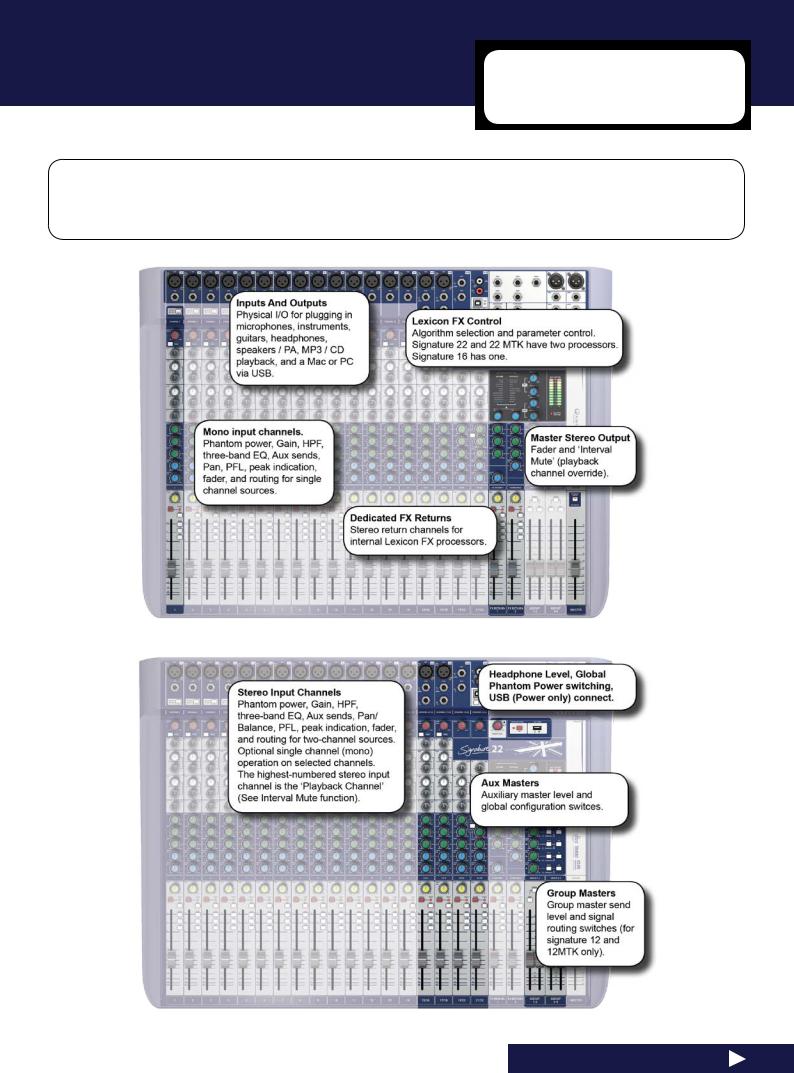
 16, 22, 22MTK User Manual
16, 22, 22MTK User Manual
2.2: PARTS OF THE CONSOLE
GETTING STARTED > PARTS OF THE CONSOLE
The diagrams show different sections of the Signature console and describes those functions. After that are more detailed descriptions of the console sections and references to the relevant chapters in this manual.
2.2: Parts Of The Console
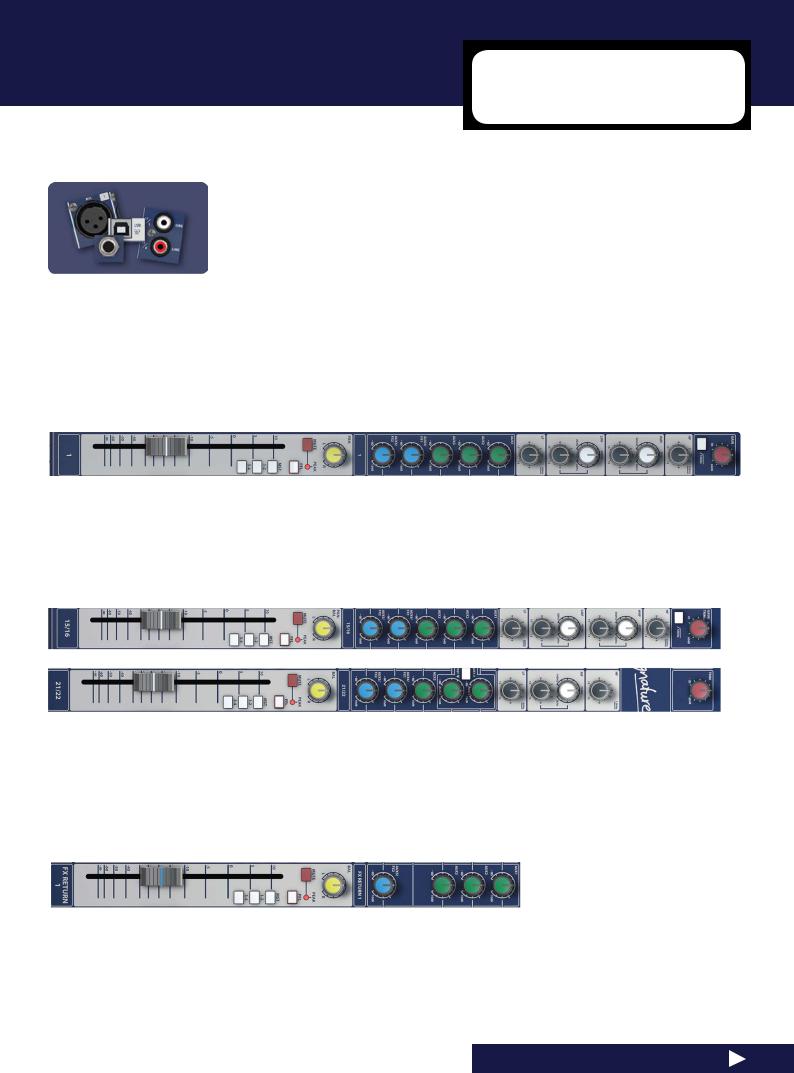
 16, 22, 22MTK User Manual
16, 22, 22MTK User Manual
2.2: PARTS OF THE CONSOLE
GETTING STARTED > PARTS OF THE CONSOLE
Inputs & Outputs
The Signature console features a variety of physical inputs and outputs for getting audio in and out of the console: XLR, Jack, and Phono for analogue audio I/O, and USB for digital audio. Refer to Section 3.0 for more detail, and to section 7.0 for detailed information on USB functionality. Note - USB functionality for MTK (Signature 22MTK) and non-MTK (Signature 16 and 22) are different; both types are detailed in section 7.0.
Mono Input Channels
Mono input channels control the levels, routing, and EQ on single channel audio inputs. All mono input channels have both microphone and line-level capability. In addition, specific channels feature Hi-Z inputs for high impedance sources such as guitar pick-ups. Refer to Sections 4.2 and 5.2 for more detail.
Stereo Input Channels
Signature 16, 22, and 22MTK consoles have two types of stereo inputs. One offers the option of a mono microphone/line level input by using either the XLR or Left/Mono Jack Input as well as stereo Jack inputs; the other (highest-numbered stereo channel) offers stereo line level phono inputs and is the ‘Playback
Channel’; the Master channel’s INTERVAL MUTE function mutes all channels except the Stereo playback channel. Refer to Sections 4.3 and 5.3 for more detail.
FX Return
A Signature FX Return channel takes it’s input from the output of the internal Lexicon FX processor. It is a stereo input channel with aux sends but without input level control or EQ. Refer to Sections 4.4 and 5.4 for more detail.
2.2: Parts Of The Console
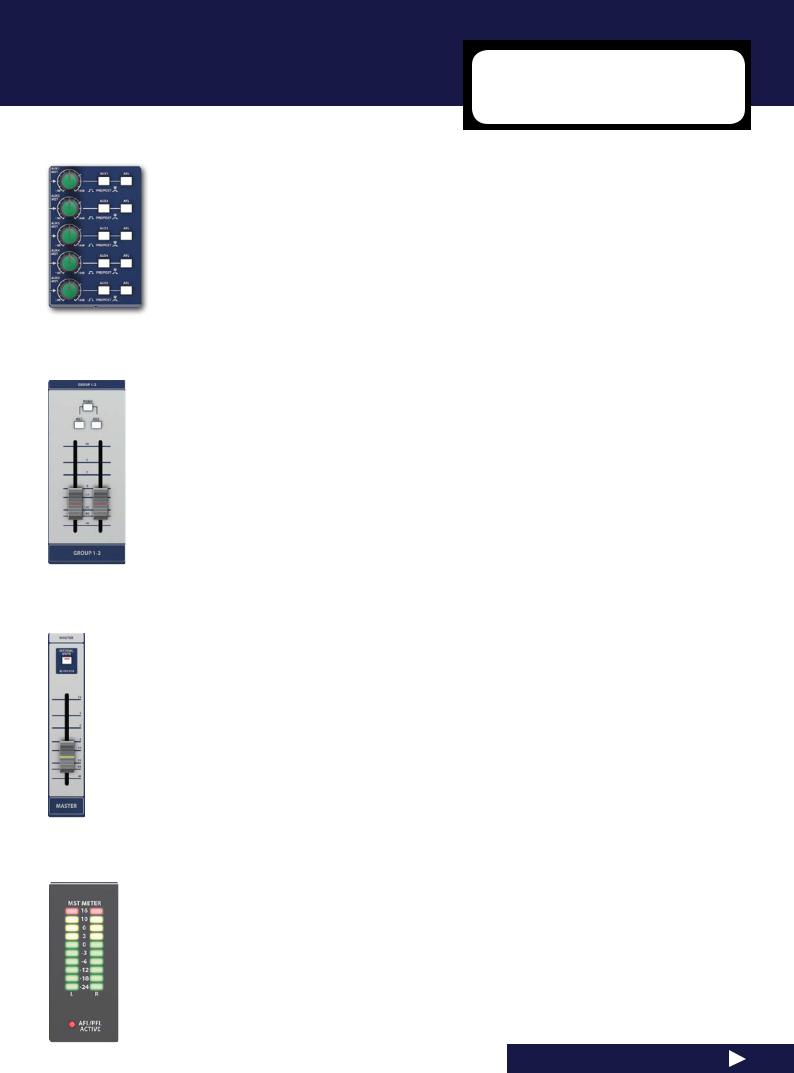
 16, 22, 22MTK User Manual
16, 22, 22MTK User Manual
2.2: PARTS OF THE CONSOLE
GETTING STARTED > PARTS OF THE CONSOLE
Aux Output Masters
Aux (Auxiliary) Master output channels control the output level of the auxiliary bus and global pre-fade/post-fader switching. AFL switching allows aux master solos. Refer to Sections 4.5 and 5.5 for more detail.
Group Output Masters
The Group Output Master channels control routing and output level for the Group busses. Groups 1 and 2, and 3 and 4 outputs can be summed to mono and/or routed to the Master Stereo Output. Refer to Sections 4.6 and 5.6 for more detail.
Master Stereo Output
Controls the output level of the Master Stereo bus. Includes the Interval Mute function (Mute all channels except the Stereo Playback Channel). Refer to Sections 4.7 and 5.7 for more detail.
Metering
The meters show the monitoring selection level - Master Left/Right output level in normal operation or the solo bus when a PFL or AFL is engaged. The AFL/PFL ACTIVE indicator is below the main meters and lights when any AFl or PFL selection is engaged. See section 6.0 for more detail.
2.2: Parts Of The Console
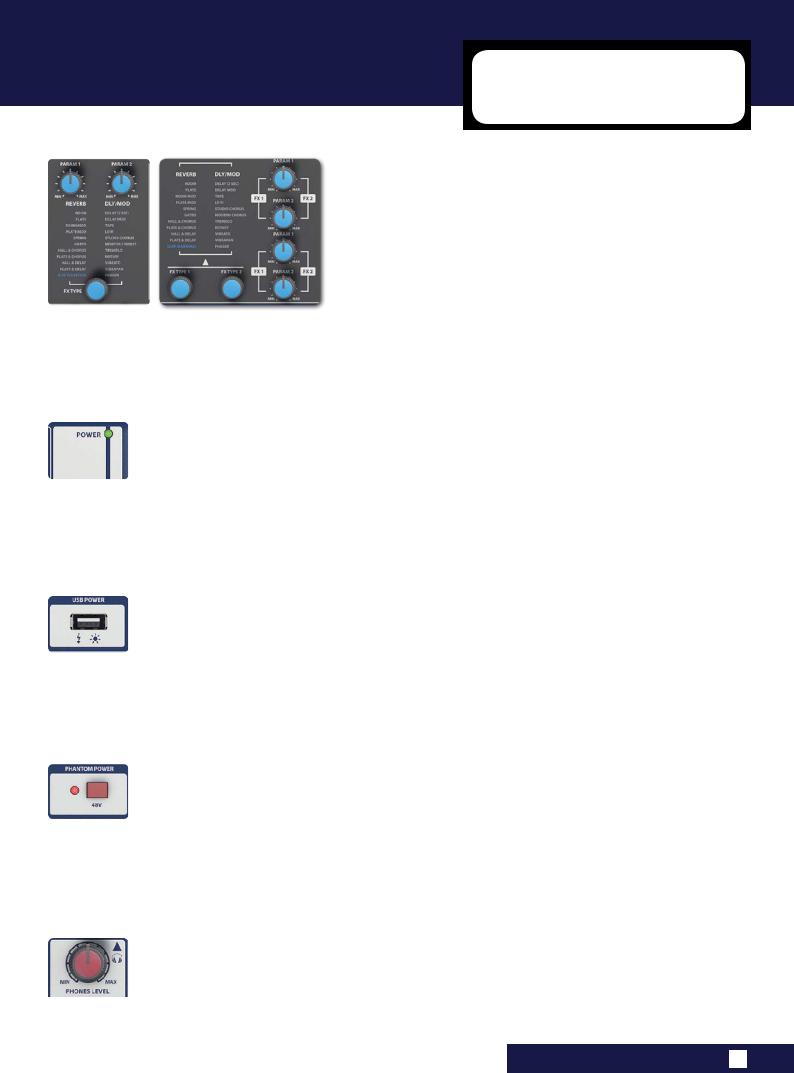
 16, 22, 22MTK User Manual
16, 22, 22MTK User Manual
2.2: PARTS OF THE CONSOLE
GETTING STARTED > PARTS OF THE CONSOLE
Lexicon FX Control
Signature 16 has a single internal Lexicon FX processor and send/return bus for adding FX such as reverb, delay, Chorus, Rotary, LoFi, Tape emulation, and more. Signature 22 and 22MTK have dual processors and send/return paths. Each Effect has two adjustable parameters. Refer to section 8.0 for more detail.
Power Indicator
Lights Green when console is powered. Power can be applied by connecting the power cord. It is good practise to turn the output level down first in case this affects any connected speakers.
USB Power Socket
For attaching powered/chargeable USB peripherals such as a USB-powered LED lamp, or a mobile phone. Not for data. There is a 500mA current limit on this connection.
Global Phantom Power Switch
Applies 48V phantom power to the console microphone inputs so you can use Condenser/ Capacitor
microphones, active DI boxes, and so on. See section 5.1 for more detail.
Headphones Level Control
Level control for the monitoring output - either the Master Stereo Output, or the Solo Bus. See section 6.0 for more detail.
2.2: Parts Of The Console
